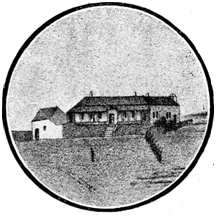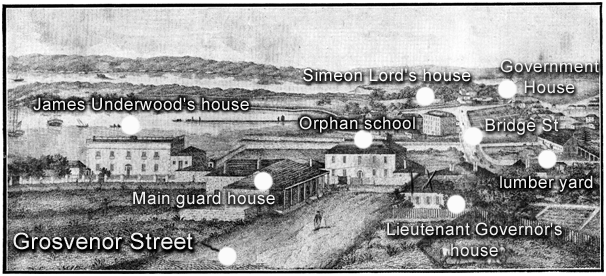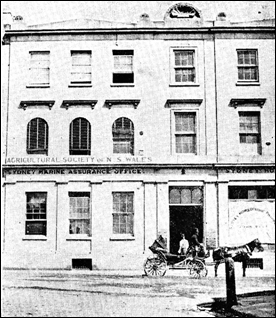Dr. Johnson, with the memory of countless nights spent at the Mitre and the Crown and Anchor, once remarked that “a tavern chair was the throne of human felicity.” If we had possessed a Johnson in Sydney in the ‘twenties there would have been many references in his indispensable Boswell to the Sydney Hotel, the site of which is the southern corner of George and Grosvenor Streets.
Great steel latticing is pushing its way to the skies at this moment on the spot as the framing for the new offices of the Union Steamship Company. The site, however, has round it far more interesting associations than that of a well-known tavern.
In fact, to begin at the beginning of its history, we must go back to the First Fleet and 1788. With Governor Phillip there came, as Lieutenant-Governor, Major Ross, and that gentleman selected this spot as the site of his house. If one could push on one side the buildings in front of it one could see what excellent taste the major display. At our feet would be the waters of the Cove, and from these, we could lift our eyes to behold the glorious length of the Harbour to the Heads.
The building was started in April 1788, and Collins, in referring to it, says: “One face of which was to be in the principal street of the intended town.” This entry is interesting, for it marks for us where Phillip’s noble street of 200 feet width was to run.

THE LIEUTENANT-GOVERNOR’S HOUSE
It stood on the southern corner of George and Grosvenor Streets. The sketch was made at the time it was occupied by Lieutenant-Governor Paterson. In front is the parade ground with a squad of soldiers at drill. The house afterwards became the Sydney Hotel.
In the plan of July 1788 the building is shown in position to the new street, which was to extend from the vicinity of the present Petty’s Hotel past the site of the house to the Cove in a straight line. The intersecting street, which the Lieutenant-Governor’s house fronted, ran at right angles to the principal street. These streets never came into being.
George Street pushed its way past the house and became the principal thoroughfare, but while the house stood it was always a reminder of Phillip’s intention, for it ran obliquely across the corner lot. After Major Ross’s departure, Major Grose, his successor, became the tenant. This gentleman evidently regarded himself as the owner, for on his departure, in 1794, he leased the premises to his successor for fourteen years. Captain Paterson, that “simple, good-natured man,” as Macquarie describes him, was one of the most interesting tenants of the house.
Peron, the French navigator, who visited Sydney in 1802, referring to the building, says that behind it “is a vast garden, which is worth the attention both of the philosopher and the naturalist, on account of the great number of useful vegetables which are cultivated in it, and which have been procured from every part of the world by its present distinguished possessor, Mr. Paterson, a distinguished traveller, and a member of the Royal Society of London.” A portion of the house and the garden may be seen in the illustration “Sydney in 1813,”.

After Paterson left the colony we find Garnham Blaxcell in possession. This gentleman, in 1817, found himself in such financial difficulties that he just quietly faded away one night, and was seen no more in New South Wales. Following him as owner and occupier we have Sir John Jamison, of whom we shall hear more in our next chapter.
Sir John let the premises, in 1820, to Mr. Stilwell, who opened it as the Sydney Hotel and Coffee Palace. This gentleman reigned only a few months when he was succeeded as a tenant by the Superintendent of Police, who gave place in December 1822, to Mr. William Cummings. This gentleman revived the Sydney Hotel, and it was while he reigned as boniface that the Sydney Hotel became the leading hotel of Sydney. It was a place of meetings, as well as a meeting house.
Mr. Cummings moved to Macquarie-place in January 1828. in January 1831, Sir John Jamison sold the materials of the old building and the site was sold in the following September.
The purchaser of the site was Mr. Samuel Lyons, who erected, in 1833, that fine block of buildings, in which was his auction room, to which Sir James Fairfax recently referred to in his memories of old Sydney. “Lyons built it, and there sold everything that might be sold under an auctioneer’s hammer. It was the birthplace of many enterprises.’ Lyons’s buildings were demolished in 1912, and the site now enters upon a new phase of existence.

PORTION OP SAM LYONS’ AUCTION ROOMS.
They stood at the corner of George Street and Grosvenor street. The Agricultural Society of N.S.W. was founded here, and its sign is visible on the second floor. The photograph was taken in 1871
